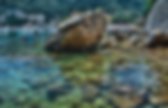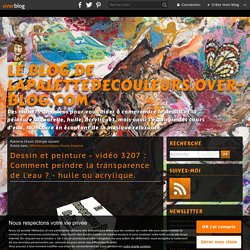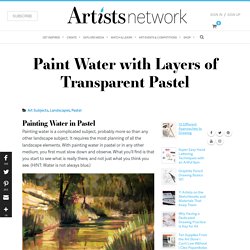

Vidéo 3264 : Comment peindre le mouvement de l'eau et la transparence (les points clés) ? - toutes les techniques. Vidéo 3207 : Comment peindre la transparence de l'eau ? - huile ou acrylique. L’eau, ainsi que de nombreux liquides ou certains matériaux comme le verre, apparaît comme transparente ET incolore, car la lumière du soleil qui l’atteint n’interagit pas du tout avec les molécules qui constituent l’eau (ou le verre, ou d’autres liquides).

Comme la lumière n’interagit pas du tout, elle ne peut que traverser l’eau et en ressortir de manière totalement inchangée (c’est-à-dire sous forme de lumière blanche). Aucune des couleurs qui constituent les rayons du soleil n’est absorbée par les molécules d’eau, qui ne sont donc pas du tout excitées, et qui ne peuvent donc pas apparaître à nos yeux avec une quelconque "couleur complémentaire"! On pourrait se demander pourquoi la lumière passe au travers de l’eau, plutôt que d’être simplement réfléchie par l’eau (comme lorsque la lumière atteint un objet opaque et coloré: on voit l’objet d’une couleur donnée, mais la lumière ne passe pas au travers de l’objet).
Peindre la transparence de l'eau, par laurentsaintgermain. Dessin et peinture -vidéo 2854 : Comment peindre la transparence de l'eau de mer ? - aquarelle. (148) Watercolor Boat on a Clear Water Painting Demonstration. (148) Acrylic Painting Tutorial on How to Paint Shallow Sea with Underwater Rocks and Sand Easy and Basic. (148) Clear Waters - Painting Lesson. Les Cailloux dans l'eau. Stones,rocks and reflections. Watercolor painting by Rukiye Garip. ETRETAT et la transparence de l'eau.
Painting Water in Pastel with Transparent Layers from Liz Haywood-Sullivan. Painting water is a complicated subject, probably more so than any other landscape subject.

It requires the most planning of all the landscape elements. With painting water in pastel or in any other medium, you first must slow down and observe. What you’ll find is that you start to see what is really there, and not just what you think you see. (HINT: Water is not always blue.) How does this water look so real? Artist Liz Haywood-Sullivan is a master at painting realistic landscapes. Four Layers of Water The bottom of the water: rocks and sandThe body of water: the color of the water itself as it is affected by its surroundings and what lies beneathReflections on top of water: trees, sky, or other things that reflect onto the top of the waterThe top layer or the water: moving currents, glints of light, ripples, and splashes Layer 1-2: Water’s Bottom and Color of Water Underpaint light greens for sunlight filtering through trees. Layer 2-3: Color of Water & Reflections.
How to Paint a "Translucent Ocean Wave on the Rocks" Part 1 - Ginger Cook's Master Class Painting. Part 2: How to Paint a "Translucent Ocean Wave on the Rocks"- Ginger Cook's Master Class Painting.